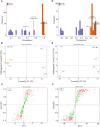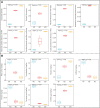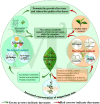Study on the effect of magnesium on leaf metabolites, growth and quality of tea tree
- PMID: 37746019
- PMCID: PMC10514580
- DOI: 10.3389/fpls.2023.1192151
Study on the effect of magnesium on leaf metabolites, growth and quality of tea tree
Abstract
Magnesium (Mg) is one of the essential elements for the growth of tea trees. In this study, we investigated changes in metabolites, photosynthetic fluorescence parameters and quality indexes of tea leaves under different concentrations of magnesium treatment, and the results showed that there were no significant differences in the quantity and total content of metabolites in tea leaves under different Mg concentrations. The results of volcano map analysis showed that the content of 235 metabolites in tea leaves showed an increasing trend and the content of 243 metabolites showed a decreasing trend with the increase of Mg concentration. The results of the combined analysis of the OPLS-DA model and bubble map showed that 45 characteristic metabolites were screened at different concentrations of Mg. Among these, the content of 24 characteristic metabolites showed an increasing trend and 21 characteristic metabolites showed a decreasing trend with the increase of Mg concentrations. The results of KEEG pathway enrichment showed that 24 characteristic metabolites with a upward trend were significantly enriched in saccharides metabolism, nucleic acid metabolism and vitamin metabolism, while the 21 characteristic metabolites with a downward trend were enriched in the synthesis of plant secondary metabolites, phenylpropanoid biosynthesis, biosynthesis of terpenoids, synthesis and metabolism of alkaloids, and synthesis and metabolism of amino acids. It can be inferred that Mg regulation was beneficial to enhance the photosynthetic capacity of tea trees, improve the accumulation and metabolism of carbohydrate substances in tea trees, and thus promoted the growth of tea trees, but was not conducive to the synthesis of secondary metabolites and amino acids related to tea quality. The results of photosynthetic fluorescence parameters and quality indexes of the tea tree confirmed the conclusion predicted by metabolomics. This study provided a reference for regulating of the growth and quality of tea trees with Mg fertilizer in tea plantations.
Keywords: magnesium; metabolomics; photosynthesis; quality; tea tree.
Copyright © 2023 Zhang, Zhang, Wang, Lin, Chen, Cheng, Du, Jia, Ye and Wang.
Conflict of interest statement
The authors declare that the research was conducted in the absence of any commercial or financial relationships that could be construed as a potential conflict of interest.
Figures







Similar articles
-
Effects of Magnesium on Transcriptome and Physicochemical Index of Tea Leaves.Plants (Basel). 2023 Apr 28;12(9):1810. doi: 10.3390/plants12091810. Plants (Basel). 2023. PMID: 37176867 Free PMC article.
-
Changes in the growth and physiological property of tea tree after aviation mutagenesis and screening and functional verification of its characteristic hormones.Front Plant Sci. 2024 Jul 24;15:1402451. doi: 10.3389/fpls.2024.1402451. eCollection 2024. Front Plant Sci. 2024. PMID: 39114474 Free PMC article.
-
Differences in transcriptomic and metabolomic analyses of metabolites of shoots on tea plants of different ages and relevant regulatory network.Front Plant Sci. 2023 Mar 2;13:910895. doi: 10.3389/fpls.2022.910895. eCollection 2022. Front Plant Sci. 2023. PMID: 36937142 Free PMC article.
-
How does tea (Camellia sinensis) produce specialized metabolites which determine its unique quality and function: a review.Crit Rev Food Sci Nutr. 2022;62(14):3751-3767. doi: 10.1080/10408398.2020.1868970. Epub 2021 Jan 6. Crit Rev Food Sci Nutr. 2022. PMID: 33401945 Review.
-
Research Progress on the Effects of Selenium on the Growth and Quality of Tea Plants.Plants (Basel). 2022 Sep 23;11(19):2491. doi: 10.3390/plants11192491. Plants (Basel). 2022. PMID: 36235356 Free PMC article. Review.
Cited by
-
Discrepancy on the flavor compound affect the quality of Taiping Houkui tea from different production regions.Food Chem X. 2024 Jun 11;23:101547. doi: 10.1016/j.fochx.2024.101547. eCollection 2024 Oct 30. Food Chem X. 2024. PMID: 38974194 Free PMC article.
-
Transcriptomic Analysis of the Effect of Pruning on Growth, Quality, and Yield of Wuyi Rock Tea.Plants (Basel). 2023 Oct 20;12(20):3625. doi: 10.3390/plants12203625. Plants (Basel). 2023. PMID: 37896087 Free PMC article.
-
Impact of Fresh Leaf Elements on Flavor Components and Aroma Quality in Ancient Dancong Tea Gardens Across Varying Altitudes.Plants (Basel). 2025 Apr 29;14(9):1339. doi: 10.3390/plants14091339. Plants (Basel). 2025. PMID: 40364368 Free PMC article.
-
Changes of physiological characteristics, element accumulation and hormone metabolism of tea leaves in response to soil pH.Front Plant Sci. 2023 Nov 16;14:1266026. doi: 10.3389/fpls.2023.1266026. eCollection 2023. Front Plant Sci. 2023. PMID: 38034585 Free PMC article.
-
Systematic review assessing the effects of amendments on acidic soils pH in tea plantations.PeerJ. 2024 Jul 24;12:e17653. doi: 10.7717/peerj.17653. eCollection 2024. PeerJ. 2024. PMID: 39071124 Free PMC article.
References
-
- Anand V., Kashyap M., Samadhiya K., Ghosh A., KIran B. (2019). Salinity driven stress to enhance lipid production in Scenedesmus vacuolatus: a biodiesel trigger? Biomass Bioenerg 127, 105252. doi: 10.1016/j.biombioe.2019.05.021 - DOI
-
- Esteves E., Kadyampakeni D. M., Zambon F., Ferrarezi R. S., Maltais-Landry G. (2022). Magnesium fertilization has a greater impact on soil and leaf nutrient concentrations than nitrogen or calcium fertilization in Florida orange production. Nutr. Cycl Agroecosys 122 (1), 73–87. doi: 10.1007/s10705-021-10182-1 - DOI
-
- General Administration of Quality Supervision, Inspection and Quarantine of the People's Republic of China (2013. a). “GBT8312-2013 Tea-Determination of caffeine content,” in Method using high-performance liquid chromatography (Beijing: China Standards Press; ), 1–5.
-
- General Administration of Quality Supervision, Inspection and Quarantine of the People's Republic of China (2013. b). GBT8314-2013 Tea-Determination of free amino acids content (Beijing: China Standards Press; ), 1–5.
LinkOut - more resources
Full Text Sources

